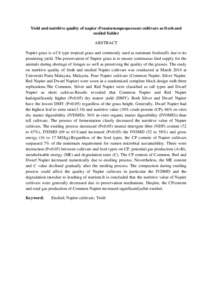Citation
Zailan, M. Z. and Yaakub, H. and Jusoh, S.
(2018)
Yield and nutritive quality of napier (Pennisetumpurpureum) cultivars as fresh and ensiled fodder.
Journal of Animal and Plant Sciences, 28 (1).
63 - 72.
ISSN 1018-7081
Abstract
Napier grass is a C4 type tropical grass and commonly used as ruminant feedstuffs due to its promising yield. The preservation of Napier grass is to ensure continuous feed supply for the animals during shortage of forages as well as preserving the quality of the grasses. The study on nutritive quality of fresh and ensiled Napier cultivars was conducted at March 2014 at Universiti Putra Malaysia, Malaysia. Four Napier cultivars (Common Napier, Silver Napier, Red Napier and Dwarf Napier) were sown in a randomized complete block design with three replications.The Common, Silver and Red Napier were classified as tall types and Dwarf Napier as short cultivar.Results revealed that Common Napier and Red Napier hadsignificantly higher (P<0.05) dry matter yield (DMY). Both Silver and Dwarf Napier have the lowest DMY (P<0.05) regardless of the grass height. Generally, Dwarf Napier had the highest leaf to stem ratio(3.18) and nutritive value (10% crude protein (CP); 66% in-vitro dry matter digestibility (IVDMD); 56% in-vitro organic matter digestibility (IVOMD)) than tall cultivars. The process of fermentation clearly decreased the nutritive value of Napier cultivars. The ensiling process decreased (P<0.05) neutral detergent fibre (NDF) content (72 to 67%), IVDMD (69 to 61%)and increased (P<0.05) the IVOMD (52 to 58%) and gross energy (16 to 17 MJ/kg).Regardless of the feed types, the CP content of Napier cultivars surpassed 7% of the minimum requirement for rumen microbial sustainability. There were interaction (P<0.05) between cultivars and feed types on CP, potential gas production (A+B), metabolisable energy (ME) and degradation rates (C). The CP content of Common, Red and Dwarf Napier increased numerically due to ensiling process. Nevertheless, the ME content and C value declined gradually after the ensiling process. The compaction during ensiling process could affect the quality of Napier cultivars in particular the IVDMD and the degradation ratesdue to leaching of nutrient.It is concluded that the nutritive value of Napier cultivars were generally decreased due to preservation mechanism. Despite, the CPcontent and total gas production of Common Napier increased significantlyafter ensiled.
Download File
![[img]](http://psasir.upm.edu.my/63736/1.hassmallThumbnailVersion/Yield%20and%20nutritive%20quality%20of%20napier%20%28Pennisetumpurpureum%29%20cultivars%20as%20fresh%20and%20ensiled%20fodder.pdf)  Preview |
|
Text (Abstract)
Yield and nutritive quality of napier (Pennisetumpurpureum) cultivars as fresh and ensiled fodder.pdf
Download (7kB)
| Preview
|
|
Additional Metadata
Actions (login required)
 |
View Item |

